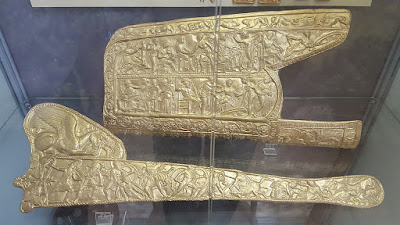A gorytos is a type of leather case for a short composite bow and arrows used by the Scythians in classical antiquity. They are a combination of bow case and quiver in one, and are worn on the archer's left hip with the opening tilted rearward. Many gorytos were highly decorated and sometimes gilded. At least one surviving specimen was determined by scanning electron microscope to be made of human skin.
Some have been found in Macedonian tombs, such as the tomb of Philip II in Macedon in Vergina of the 2nd half of the 4th century BCE. It is thought to have belonged to his sixth wife, the Thracian princess Meda of of Odessos, who hurled herself on his funeral pyre. Her remains were found in the antechamber of Philip's tomb. They were also used by the Persians. Indo-Greeks adopted the composite bow and the gorytos as part of their mounted archery equipment from around 100 BCE, as can be seen on their coins.
In his 1913 book, Scythians and Greeks: A Survey of Ancient History and Archaeology on the North Coast of the Euxine from the Danube to the Caucasus, Ellis H. Minns states these quivers found in Scythian graves contained from 200 to 300 shafts. Later sources point to burials with 180 and 128 arrows.
"Those are remarkable numbers. Soldiers in Babylonia in the same period usually carried 30 to 60 arrows, [and] the Strategikon recommends that Roman soldiers carry 30 or 40 in a quiver," observes Sean Manning of https://bookandsword.com, "These western Scythian (to use the Greek name) or Kimmerian (to use the Babylonian name) bows were designed for a style of fighting which involved putting vast numbers of arrows into the air. Such small, light arrows might not penetrate shields or inflict immediately disabling wounds, but if enough arrows were in the air that would not matter. The peoples of the western steppes were accused of poisoning their arrows, and that is certainly a common solution for archers forced to use short or light bows."
You can read his full article here:
https://bookandsword.com/2018/03/03/how-many-arrows-in-a-scythians-gorytos/
 |
| Copies of a Gorytos and sword sheath excavated from a 4th century BC Scythian king burial in the Azov History, Archaeology and Paleontology Museum courtesy of Wikimedia Commons contributor Altes. |
| Gilded gorytos found in the antechamber of the tomb of Philip II thought to belong to his sixth wife, Meda of of Odessos courtesy of Trip Advisor contributor Ольга Р |
 |
| Reconstruction of an armored 5th century BCE Scythian warrior with shield, short sword, spear and gorytos, based on finds from a burial at Gladkovscina in the Ukraine courtesy of Book and Sword. |
No comments:
Post a Comment